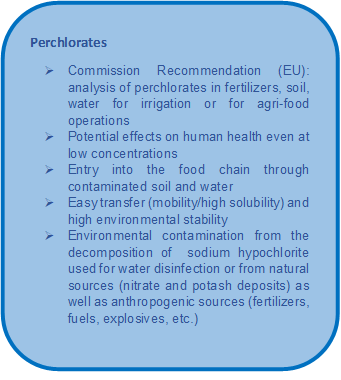Determination of perchlorate in soil and drinking water in ALS laboratories
Aug 4, 2020
ALS laboratories developed a completely new method for the determination of perchlorate in soil and drinking water.
Perchlorate belong to monitored environmental contaminants. Their origin can be both from natural sources (e.g. from nitrate and potash deposits, i.e. potassium carbonate or formation in the atmosphere) and as a result of human activity (widespread use of nitrogen fertilizers, production / use and disposal of ammonium perchlorate from industrial processes of solid fuels, explosives, fireworks, flares, inflatable airbags, etc.).
Perchlorate can also be formed during the decomposition of sodium hypochlorite used to disinfect water and can thus contaminate drinking water supplies.

From a toxicological point of view, perchlorate pose a significant problem, as they cause an adverse effect the human hormonal system through the inhibition of the thyroid function by disrupting the absorption of iodide, which is essential for hormone synthesis. These hormones are important for normal growth, development and metabolism of people, especially the babies.
The maximum permitted amount of perchlorate has so far been published as recommended in drinking water. The reference dose (RfD) for exposure to perchlorate from food and water is set at 0.7 μg / kg body weight / day. The WHO states that recommended limit for perchlorate is 0.07 mg / l of drinking water. In Europe, EU Commission Recommendation 2015/682 of 29 April 2015 on monitoring the presence of perchlorate in food has been issued for the time being, within which monitoring of drinking water is recommended.
 Although limit levels of perchlorate in soil and water have not yet been tightly regulated, it is expected that this will change in the future, as the World Health Organization (WHO) is working intensively on this issue. However, legislative limits have already been set for food, with water, soil and fertilizers being considered as potential sources of perchlorate contamination.
Although limit levels of perchlorate in soil and water have not yet been tightly regulated, it is expected that this will change in the future, as the World Health Organization (WHO) is working intensively on this issue. However, legislative limits have already been set for food, with water, soil and fertilizers being considered as potential sources of perchlorate contamination.
Determination of perchlorate in soil and water
Analysis of perchlorate anions in soils and water is performed by a fast, sensitive and reliable method by ultra-high-performance liquid chromatography tandem mass spectrometry (UHPLC-MS/MS). The methods are fully validated and accredited by the Czech Accreditation Institute (CIA). Thanks to modern technology and the experience of our analytical teams, we achieve very low limits - 0.2 μg/L for water and 0.002 mg/kg dry matter for soils.
If you have a request for the determination of perchlorate or consulting in the field of sampling or other laboratory analyses, do not hesitate to contact us at +420 226 226 228 or by e-mail at customer.support@alsglobal.com.
References:
https://clu-in.org/contaminantfocus/default.focus/sec/perchlorate/cat/Policy_and_Guidance/
https://www.epa.gov/sdwa/perchlorate-drinking-water
https://apps.who.int/iris/bitstream/handle/10665/254637/9789241549950-eng.pdf;jsessionid=3173E1623B4102722BFBE3EC0AB28F09?sequence=1
https://www.who.int/water_sanitation_health/water-quality/guidelines/chemicals/perchlorate-background-jan17.pdf?ua=1
https://www.who.int/water_sanitation_health/water-quality/guidelines/chemicals/perchlorate-fs-2017.pdf?ua=1
https://eur-lex.europa.eu/legal-content/CS/TXT/PDF/?uri=CELEX:32015H0682&from=PL

